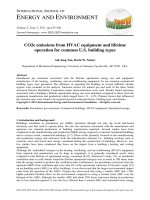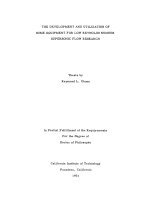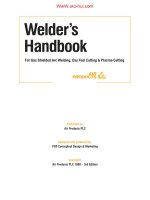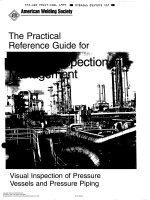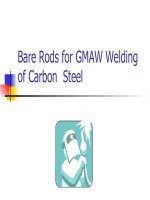Equipment for welding
Bạn đang xem bản rút gọn của tài liệu. Xem và tải ngay bản đầy đủ của tài liệu tại đây (2.22 MB, 29 trang )
Equipment for Welding
Equipment for Welding
Introduction to Welding Circuit
Current and Circuit Polarity
Cables, Electrodes
Arc welding power sources, DC and AC Power sources,
Welding Positioners, Manipulators, Robotic Arms
Automation in Welding
Equipment for Welding
Introduction to Welding Circuit
Equipment for Welding
Effect of Circuit Polarity
Equipment for Welding
Introduction and Classification of Power Sources for Welding
Also known as Power Supplies and Welding machines
Important Concepts
1. Duty Cycle
Percentage of any given 10-minute period that machine can operate at rated current without overheating or breaking down
Rating of 100% means machine can be used at rated amperage on continuous basis
Required by continuous, automatic machine welding
Rating of 60% means machine can be used at its capacity 6 out of every 10 minutes without damage
Satisfactory for heavy SMAW and GTAW
Equipment for Welding
Introduction and Classification of Power Sources for Welding
Also known as Power Supplies and Welding machines
Important Concepts
2. Efficiency
Relationship of secondary power output to primary power input
Indicated in percent
Determined by losses through machine when actually welding at rated current and voltage
Average efficiencies
Motor generator welding machines: 50%
Transformer-rectifier: 70%
Inverter: 85%
Equipment for Welding
Introduction and Classification of Power Sources for Welding
Also known as Power Supplies and Welding machines
Many different methods of classification
Two Important Classifications
1. Power source type
i. Rotating (Generator)
ii. Static
a. Transformer
b. Transformer-rectifier
c. Inverter
2. Output slope
i. Constant Current CC- Also Referred to as Variable Voltage
ii. Constant Voltage CV- Also Referred to as Variable Current
Equipment for Welding
Introduction and Classification of Power Sources for Welding
Equipment for Welding
Selection of Power Source Relative to Welding Process
Because no single power source is right for all welding situations, it is necessary to know the processes to be used before selecting the
best power source.
Equipment for Welding
Introduction and Classification of Power Sources for Welding
Classification - Out Put Slope
2. Output slope
i. Constant Current
Current remains fairly constant regardless of changes in arc length. Called drooping voltage, variable voltage, or droppers Load
voltage decreases as welding current increase.
ii. Constant Voltage
Voltage remains fairly constant regardless of changes in current.
Equipment for Welding
Introduction and Classification of Power Sources for Welding
Classification - Out Put Slope
Equipment for Welding
Introduction and Classification of Power Sources for Welding
Classification - Out Put Slope
Equipment for Welding
Introduction and Classification of Power Sources for Welding
Classification – Power Source Type
1. Generated (Rotating)
i. Motor Driven
Current remains fairly constant regardless of changes in arc length. Called drooping voltage, variable voltage, or droppers Load
voltage decreases as welding current increase.
ii. Engine Driven
Powered by gas or diesel combustion engine
Can be found with a.c. or d.c. electric motor
No longer being manufactured and rarely found
Equipment for Welding
Introduction and Classification of Power Sources for Welding
Classification – Power Source Type
1. Generated (Rotating)
i. Motor Driven
Equipment for Welding
Introduction and Classification of Power Sources for Welding
Classification – Power Source Type
Motor Driven Generators Desirable Characteristics
Have forceful penetrating arc
Versatile - Can be used to weld all metals that are weldable by arc process
Flexible - With proper electrode, can be used in all positions
Durable and have long machine life
Requires considerable maintenance due to moving parts
The Lincoln Electric Co.
Equipment for Welding
Introduction and Classification of Power Sources for Welding
Classification - Power source type
ii. Static (Converted Power)
a. Transformer
Use basic electrical transformer to step down a.c. line power voltage to a.c. welding voltage
b. Transformer-rectifier
Use basic electrical transformer to step down a.c. line power voltage to a.c. welding voltage
Welding voltage then passed through rectifier to convert a.c. output to d.c. welding current
May be either d.c. or a.c d.c. machines
c. Inverters
Increases frequency of incoming primary power
Constant current, constant voltage, or both
Produce a.c. or d.c. welding current
Miller Electric Mfg. Co
Equipment for Welding
Introduction and Classification of Power Sources for Welding
Classification - Power source type
ii. Static (Converted Power)
a. Transformer- AC
Most popular a.c. welding machine
Function of transformer
Step down high voltage of input current to high amperage, low voltage current required for welding
Especially suited for heavy work
Reduces tendency to arc blow
Can use larger electrodes resulting in faster speeds on heavy materials
Lower cost
Decreased power consumption
High overall electrical efficiency
Noiseless operation
Reduced maintenance
Equipment for Welding
Introduction and Classification of Power Sources for Welding
Classification - Power source type
ii. Static (Converted Power)
b. Transformer- Rectifier
Have many designs and purposes
Flexibility is one reason for wide acceptance
Deliver either DCEN or DCEP
May be used for:
Stick electrode welding
Gas tungsten arc welding
Submerged arc welding
Multi-operator systems
Stud welding
The Lincoln Electric Co.
Miller Electric Mfg. Co.
Equipment for Welding
Introduction and Classification of Power Sources for Welding
Classification - Power source type
ii. Static (Converted Power)
b. AC / DC Transformer- Rectifier
Permit welder to select either a.c. or d.c. and electrode negative or electrode positive Switch
Permits welder to use only transformer part of machine for a.c. welding
Flipping switch then output current directed through rectifier which converts it to d.c. welding
High frequency arc-starting devices, water/gas flow
controls, balance controls for a.c. operation,
remote control often built into machine
The Lincoln Electric Co.
Equipment for Welding
Introduction and Classification of Power Sources for Welding
Classification - Power source type
ii. Static (Converted Power)
b. DC and AC/DC Inverters
Portable, lightweight, and versatile
May be either constant current, constant voltage or both Can perform several different processes
Miller electric Mfg. Co.
The Lincoln Electric Co.
Equipment for Welding
Miscellaneous - ELECTRODE AND WORK CABLE
Required to complete electric circuit between welding machine and workElectrode cable (welding cable) attached to electrode holder
Work cable attached to work
Rubber-covered multistrand
copper cable generally used
Must have high flexibility
CABLE CORE CONSTRUCTION
Woven of thousands of very fine copper wire
Greater the number of strands the more flexible
Components
A. Wires stranded for extra flexibility
B. Paper wrapping around wires
allows conductor to slip within
robber covering when bent
C. Extra strength from open-braided
reinforcement of extra cotton cords
D. Special composition and curing of
heavy rubber covering
Equipment for Welding
Miscellaneous - ELECTRODE AND WORK CABLE
WORK CABLE
Not necessary to have flexibility of electrode cable
Usually same cable used
Important considerations
Amperage of welding machine
Distance from work
Larger cable
Greater the amperage and greater the distance
Resistance increases as diameter of cable decreases
Equipment for Welding
Miscellaneous – CABLE LUGS
Required on both electrode cable and work cable
Soldered or fastened mechanically
Connections MUST be tight and secure
Miscellaneous – WORK CLAMPS
Variety of structures to be welded; many types of clamps may be used
Copper hook, heavy metal weight, C-clamp
Specialized work clamps
Miscellaneous – QUICK CONNECTORS
Attached to ends of different lengths of cables
Allow quick and easy attachment to any length cable
Lenco dba NLC. Inc.
Equipment for Welding
Miscellaneous – METAL ELECTRODE HOLDERS
Device used for holding electrode mechanically
Conveys electric current from welding cable to electrode
Insulated handle protects hand from heat
Jaws of holder grip electrode at any angle
Made of metal with high electrical conductivity and ability to withstand high temperatures
Jaws can be replaced with new ones
Should be light in weight, well-balanced and have comfortable grip
Size of holder must be in line with size of welding machine
Fully insulated so stays cool even with high duty cycles
Equipment for Welding
Miscellaneous – SPRING TYPE ELECTRODE HOLDERS
Equipment for Welding
Miscellaneous – Turning Rolls

